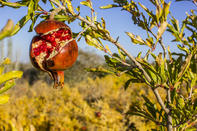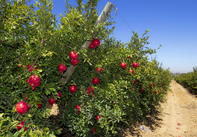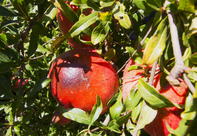
Pruning Pomegranates
Pomegranates can grow as either multi-stem shrubs (three to six stems are best) or as single stem trees. Take care to limit the height of the tree to 2 - 2,5 m as this is easier for manual labour.
\When establishing new pomegranate orchards, farmers should endeavour that about 80% of manual labour in the orchard should be done without the use of ladders, advises Jorrie Mulder, technical adviser of the Pomegranate Producer’s Association of South Africa - POMASA.
Multi-stemmed pomegranate trees tend to ripen earlier and often have more fruit-bearing branches while in a single-stem orchard it is easier to remove suckers (extra new shoots) at the base of the stem.
Both multi-stemmed and single-stem trees yield similar amounts of fruit. Pruning of the fruiting tree will consist mainly of the removal of excess growth, dead branches and suckers.
To achieve the desired shape and height of the tree, it should be pruned in winter. To keep the interior of the tree open (for better penetration of sunlight and reducing humidity) summer pruning is advised.
Trellising Pomegranates

Trellising pomegranate trees is recommended to support the branches bearing the heavy fruit. As the fruit ripens, it weighs the branches down. This will expose the fruit to the sun and can lead to severe sunburn.
A V-shape trellising system will support the branches, open up the inside of the shrub to better sun exposure and will also allow better penetration of sprays.
Three more advantages of trellising pomegranates are: Trellising reduces wind damage (chafing) on fruit. Fruit on trellised trees is less likely to rub against other fruit on windy days. Less sunburn. Trellising allows the branches to grow in a way that the fruit is protected by the leaves. Trellising increases the surface area for bearing fruit.
Thinning of Fruits
Pomegranates flower in three flushes from September to November, which means fruit will ripen in stages and will have to be harvested several times.
Generally, early flowers produce bigger fruit (longer growing season). Too much fruit on the trees negatively impacts on fruit size as well as the fruit yield of the following season.
To avoid this, thinning of fruit about a month after flowering is useful. It is also important to thin fruit growing in clusters - take off the smaller fruit. Fruit clusters create an ideal environment for insects and diseases to thrive. Also thin out damaged fruit and fruit growing on weak branches.
Sunburn in Pomegranates

Pomegranates grow mainly in the warmer areas with summer temperatures averaging between 32℃ and 35℃. In young trees with few leaves, this intense sunlight may cause sunburn in the form of huge black spots on the fruit skin. This will make the fruit unmarketable and may also lead to fruit cracking.
Several measures can be taken to prevent sunburn: Adjusting irrigation and fertilising. Application of UV-protection agents. Paper bags: Disadvantages include chafing (caused by paper rubbing on the skin), pests still manage to penetrate to damage the fruit and cost. Shade netting: Evaluations of various shade netting in the Riebeeck Valley is currently being conducted (2019). Use a trellis system.
Plant Protection in Pomegranates
Not much research has been done in South Africa on pests and diseases of pomegranates, but several new crop sprays have been registered for use on pomegranates between 2014 and 2018. The ‘Alternative Crops Fund’ of the Western Cape’s Department of Agriculture allocated funds for these crop registration programs.
This has helped to increase the exports of pomegranates, as it helped to open new markets to South African pomegranates. The main pest of pomegranate is the false codling moth. Other pests include aphids, mealy bug, scale, fruit fly and thrips. Thrips cause skin damage that leads to cracking and secondary infections.
The most important diseases of pomegranates are botrytis (crown rot), Alternaria (black heart), Phytophtera and bacterial blight. Physical disorders include internal breakdown, fruit cracking, chilling injury and deformed fruit.
Most often, defective fruit is sorted in the orchard, which requires only minimal sorting to be done in the pack shed. The main disorder of pomegranates is the splitting of ripe fruit and may damage up to 50% of the harvest. Regular irrigation and a proper fertiliser program may limit the damage.
By Marinda LouwFor bulk or export enquiries please use the enquiry link below.